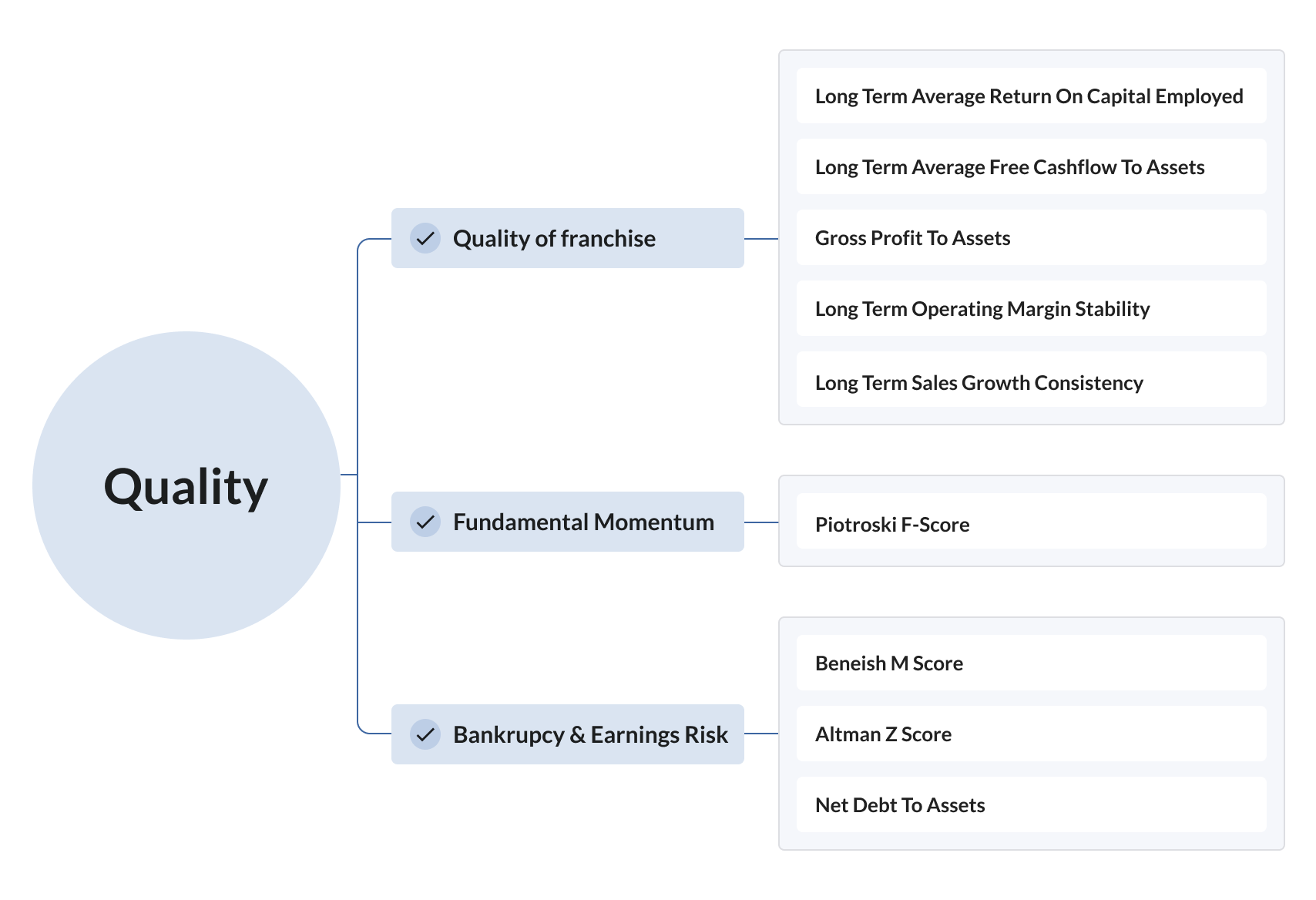The Quality Factor - quality beats junk
You don't want to buy things that are cheap. You want to buy things that are good. It's much better to buy something that's good at a fair price, than something that is cheap at a bargain price. Warren Buffett
There are more than 160,000 Chartered Financial Analysts in the world today, trained in all the methods that Warren Buffett used to make himself over $100bn of wealth. With 40 CFAs for every listed stock in the USA, you'd think that high quality stocks would be fully recognised. Yet they aren't. Quality stocks appear to be systematically underpriced by the market. This provides an opportunity to investors willing to profit from slow compounding growth.
Background on Quality Investing
Many of Ben Graham's students went on to become highly successful investors, but one stands head and shoulders above the rest. Warren Buffett. For a long time, in the early days of his investment practice, Buffett invested predominantly in deep value stocks. But gradually he learned that bargain stocks often remain bargains - they can be cheap for a reason.
Ironically, his biggest lesson came from his purchase of a struggling textiles firm. He struggled to turn it around, losing money hand over fist on the textiles operation while diversifying away into more profitable insurance & investment practices. If he hadn't bought this firm, he believes he'd be $200bn wealthier. That firm's name was Berkshire Hathaway.
It was the writing of Philip Fisher[1] who most influenced Buffett & his business partner Charlie Munger away from pure value investing. Fisher recommended buying businesses with growth opportunities, high margins, profitability and cashflow, proprietary products and a leading industry position.
These ideas would be transformational to Buffett who gradually started buying great businesses at reasonable prices, rather than bargain stocks. He wished to identify great quality 'franchises', companies with pricing power and an economic moat, rather than commodity businesses.
The ideas around what a 'Quality' stock is have evolved over time. Many great management gurus and consultants have built frameworks for understanding the more qualitative aspects of good businesses - analysing the management, industry position, business model, competitive advantage. But more recently, the academic community has weighed into the debate, publishing many papers that suggest buying groups of stocks with certain quantitative traits - factors - leads to market beating results.
Indeed, one controversial paper titled Buffett's Alpha[2] suggested that all of Berkshire Hathaway's returns could be replicated by buying low risk, high quality stocks using purely quantitative factors. The authors suggest that Buffett's genius wasn't actually as a stock picker - it was recognising these factors worked before anyone else did.
How to measure Quality?
The academic community was fairly slow to catch onto proving the power of quality stocks, but the last few decades are peppered by a trail of powerful ideas that can be used in stock selection.
Here are just a few:
1968 - Edward Altman showed how to avoid stocks at risk of bankruptcy (The Z-Score). [3]
1996 - Richard Sloan showed how cash generative companies with conservative accounting practices tend to outperform (low Accruals). [4]
1999 - Messod Beneish showed that companies that cook their books underperform (the M-Score). [5]
2000 - Josef Piotroski showed that buying stocks with improving profitability, liquidity and efficiency and decreasing leverage increased value investing returns by 7.5% annually (the F-Score). [6]
2004 - Partha Mohanram showed that stocks with more stable earnings and sales growth tend to outperform (the G-Score). [7]
2013 - Robert Novy Marx showed that stocks with high gross profitability tend to outperform. [8]
As the debate matured, some began combining these ideas into composite measures that could be used for portfolio construction. We were watching closely, and in 2013 - we launched the Quality Rank - as a way to instantly assess a company's Quality across a range of these kinds of factors.
A few months later, a study called Quality Minus Junk[9] by Asness, Frazzini and Pedersen of AQR Capital, enormously raised the profile of the Quality Anomaly. Their framework used a combination of factors across profitability, growth, safety and payout to illustrate how Quality beats Junk across 24 countries globally by more than 5% per year. This was a further affirmation that our approach had merit.
Why does the Quality Effect work?
We're continually told that to achieve higher returns, we need to take on higher risk. But high quality stocks are less volatile than the market, outperform in recessions and benefit from a flight to quality when markets crash. Quality stocks are low risk and they outperform. So attempts to find a risk based explanation to this ‘anomaly’ have generally failed.
It seems more likely that there is a behavioural explanation to the outperformance of quality stocks - that investors systematically underestimate the real value of these firms. Studies by Bouchaud et al in 2016 [10]explore this point by focusing on the behaviour of professional stock analysts. He explains that stock market analysts may overestimate the quality of their private information while being slow to react to public cashflow measures. Analysts appear to create over-optimistic forecasts that they only reluctantly change on new information.
Whatever the true reason behind the anomaly, it's one that individual investors can capitalise on with a simple rule of thumb: Buy Quality, avoid Junk.
As the great Peter Lynch once said:
Invest in simple companies that appear dull, mundane, out of favor, and haven’t caught the fancy of Wall Street.
Stockopedia's QualityRank
As an individual investor, you are at the mercy of social media gurus, hype in the press and sponsored research reports paid for by the companies themselves. One of the best antidotes to this is a clear, objective measure of quality that helps you cut through the noise.
Stockopedia's QualityRank, which scores all the stocks in the market between zero (worst) to 100 (best), is inspired by the best of the research above and analyses a company across a range of factors across three main categories:
1. Is it a good business?
Warren Buffett is famous for his ability to measure the quality of a company's franchise. While we can't replicate the qualitative aspects of his genius, it is possible to assess a company for its short and long term sustained profitability, cashflow, margins and growth. We focus on the following measures to calculate a "Franchise Rank":
Profitability: Long Term Average Return on Capital Employed
Profitability: Gross Profits to Assets
Cashflow: Long Term Average Free Cashflow to Assets Ratio
Margins: Long Term Operating Margin Stability
Growth: Long Term Sales Growth Consistency
2. Is it an improving company?
As research analysts are so focused on attention grabbing headline figures like high profits, they often miss subtle turning points in company fundamentals. Joesph Piotroski wrote a highly influential paper in 2000 devising a clever 9 point checklist to identify stocks improving across these measures - it's proven particularly effective at predicting future returns.
Financial Trend: using the Piotroski F-Score to identify stocks with improving fundamentals.
3. Is it a safe company?
Ultimately no investor in their right mind should wish to own an overly leveraged stock with a high risk of bankruptcy, or a high risk the finance director may be cooking the books. So we integrate three key factors of safety and use them to decrement the overall Quality Rank as the severity of the risks increase.
Bankruptcy Risk: we use a sector dependent Altman Z-Score to avoid stocks in financial distress
Earnings Manipulation Risk: we use the Beneish M-Score to help avoid stocks with accounting shenanigans
Leverage: we rank against high indebted businesses using the Net Debt/Assets
Each company in the market is ranked from 1 to 100 for all of these component factors and they are combined using a proprietary weighting formula. The QualityRank is then calculated as a percentage rank between zero and 100 for this formula, and published daily for instant assessment.
- Philip Fisher. Common Stock and Uncommon Profits.
- Andrea Frazzini, et al. Buffett’s Alpha. 2019
- Edward Altman. Financial Ratios, Discriminant Analysis and the Prediction of Corporate Bankruptcy. 1968
- Richard Sloan. Do Stock Prices Fully Reflect Information in Accruals and Cash Flows About Future Earnings? . 1996
- Messod Beneish. The Detection of Earnings Manipulation. 1999
- Joseph Piotroski. Value Investing: The Use of Historical Financial Statement Information to Separate Winners from Losers. 2000
- Partha Mohanram. Separating Winners from Losers Among Low Book-to-Market Stocks Using Financial Statement Analysis. 2004
- Robert Novy-Marx. The Other Side of Value: Good Growth and the Gross Profitability Premium. 2013
- Clifford Asness and Andrea Frazzini. Quality minus Junk. 2017
- Jean-Philippe Bouchaud. Sticky Expectations and the Profitability Anomaly. 2016

